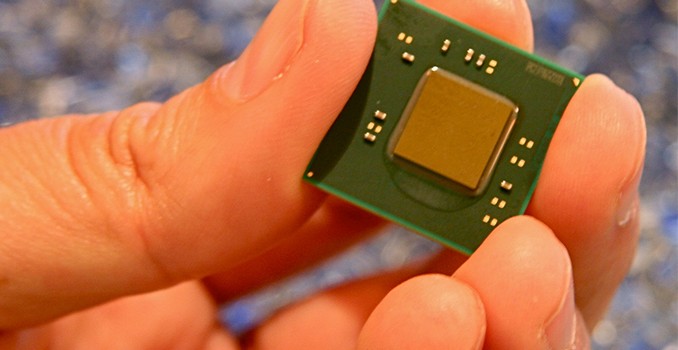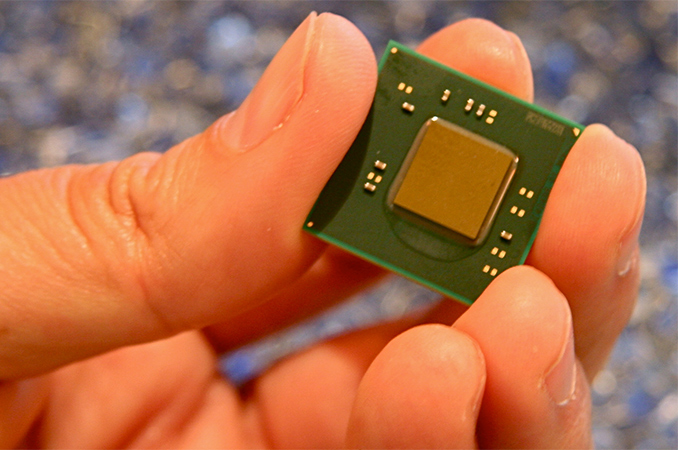Spreadtrum SC9861G-IA: An Intel Atom Octocore Smartphone SoC on 14nm with LTE
Last year Intel decided to cease development of its smartphone SoCs and focus instead on microprocessors for other devices, as well as LTE, 5G modems, as well as various IoT solutions. While we weren't expecting a new x86 SoC in the space, Intel did not specify that would be the case: the agreements with third-party SoC developers such as Spreadtrum and Rockchip were still in place. Despite this, we were surprised to hear that At MWC 2017, Intel’s partner Spreadtrum introduced a brand new application processor for high-end handsets, featuring Intel’s 2015 Airmont cores (as seen in Cherry Trail) and made using Intel’s 14 nm process technology.
The Spreadtrum SC9861G-IA SoC features eight Intel’s Airmont cores with running at up to 2 GHz, with Imagination Technology's PowerVR GT7200 GPU. Also integrated is Spreadtrum's own 5-mode LTE Cat 7 modem (up to 300 Mbps download, up to 100 Mbps upload). The SoC also integrates an ISP that supports up to two 13 MP camera sensors, a dedicated sensor hub, and hardware-based decoders/encoders for HEVC and other popular video codecs that support up to 3840×2160 resolution. The display controller can handle resolutions up to 2560×1600.
| Spreadtrum's 8-Core Airmont SoC | |||
| SC9861G-IA | |||
| CPU Cores | 8 × Intel Airmont at up to 2 GHz | ||
| GPU | PowerVR GT7200 | ||
| Imaging Capabilities | Up to 26 MP, up to two 13 MP sensors |
||
| Video | 4Kp30, HEVC | ||
| Display Controller | 2560 × 1440 | ||
| Modem | TD-LTE/FDD LTE/TD-SCDMA/WCDMA/EGG LTE Category 7 (DL: 300Mbps, UL: 100Mbps) |
||
| Process Technology | 14 nm | ||
To date, the Spreadtrum SC9861G-IA is the most powerful (and presumably energy-efficient) x86-based SoCfor smartphones. It has more cores, better graphics, and a faster modem than Intel’s own code-named Moorefield SoCs introduced in 2014, made using its 22 nm fabrication process, or the SoFIA chips (designed by Rockchip) launched in 2015 made using TSMC’s 28 nm technologies. Using Intel’s 14 nm manufacturing technology for this new SoC helps to reduce minimum power requirements and die size (which still remain unknown).
The SC9861G-IA is the first x86-based SoC by Spreadtrum, and the development was enabled by an agreement signed in late 2014 after Intel acquired a $1.5-billion worth stake in Tsinghua Unigroup, the owner of Spreadtrum. The chip will not carry the Intel Atom brand, and thus Intel will not help makers of devices to integrate it or make any other incentives to popularize the platform. It will also not invest in its advertising. What is interesting is that the SC9861G-IA will not be Spreadtrum’s last x86-based SoC, according to the CEO of Intel.
“We look forward to working with Spreadtrum on additional mobile platforms,” said Brian Krzanich.
Neither company elaborated on the future plans, and we do not know whether Spreadtrum will continue to introduce smartphone SoCs featuring Intel’s low-power cores, or if they will launch something for higher-end tablets as well.
Intel and Spreadtrum did not disclose when they expect the first devices based on the SC9861G-IA to show up, but only noted that the platform can address both mainstream and high-end handsets.


